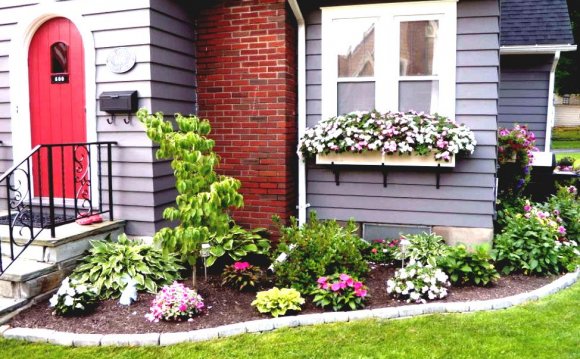
When it comes to flower garden design, it's mostly up to you. Sure, it's important to do a good job of soil preparation and carefully match plants to the site. If you ignore these imperatives, your results will likely be disappointing.
The aesthetics, however, are more a matter of personal preference. You might prefer a formal look with straight edged beds and plants in orderly patterns. Or you might prefer a more natural look with sweeping curves and irregular clumps of plants. The styles you choose are up to you.
The tips below avoid as much as possible the prescriptive "shoulds" that dominate advice about garden design. Instead, they'll point out the aesthetic consequences of different strategies. Remember that, in most cases, there is more than one way to arrange plants, and that many of the "rules" of garden design were made to be broken. What's important is that your garden look good to you.
Match plants to the sun
Break this rule at your own peril. Different plants need different amounts of light. Most candidates for flower gardens prefer full sun (6 or more hours of direct sun each day). Others need full- or part-shade. Some plants may grow fine in the shade but flower better in full sun.
Pay attention to soil needs
This is the other unbreakable rule. Most garden plants need well-drained soil. Unless you are going to limit yourself to plants that can tolerate boggy soil conditions, avoid locating flower gardens where there is standing water after heavy rains or during the spring thaw. Prepare soil well in advance of planting - preferably in fall for planting the following spring.
Where to plant?
Plant flower beds where you can see them. Especially consider the views from private outdoor spaces such as patios, decks, and terraces. Don't forget about how the beds will look when viewed through windows from inside the house. Also consider how neighbors and passersby will see your gardens.
Trees are tough
One of the most tempting places to put your flower garden is around the base of a mature tree. This is one of the most difficult places to grow flowers, however, because of the deep shade and intense competition for moisture and nutrients from tree roots. Very few plants will thrive here - with the exception of some tough, competitive groundcovers.
Start a sketch
Now might be a good time to start sketching your design plans on paper. Start with the footprint of your house. Add the garage, other buildings, driveway, walks, fences, and patios. Sketch in existing trees and other plantings. Indicate which way is north on your sketch so that you become more aware of how much sun different places receive. For example, areas close to the north sides of buildings get little direct sun.
Consider the slope
Flower gardens are easiest to establish on level or slightly sloping ground. Steep slopes pose special problems, especially protecting soil from erosion. They may require terracing if you want to create flowerbeds without losing soil. Such slopes might also be good candidates for a tough, spreading, mat-forming groundcover. Some steep slopes might be ideal sites for rock gardens. Indicate steep slopes on your sketch.
Foundation plantings
Many homes are girdled by often-overgrown evergreen shrubs. With older homes, the purpose of these plantings was to hide ugly foundations and basement windows. Most newer homes lack ugly foundations, but many still sport the shrubs - more out of tradition than anything else. Consider removing some of these shrubs and using the space occupied by foundation plantings for flower beds or mixed plantings, or creating beds in front of the shrubs.
Borders and islands
Returning to your sketch, look for likely spots for creating new flower beds. These may be border beds, tied along one edge to a building, fence, or walkway. Or they may be island beds, carved out of the middle of the lawn.
Background
Before you pencil in potential bed locations, consider the background. Most plantings benefit from a background to provide some visual contrast to the plants. Buildings, fences, hedges, or a row of evergreen trees can keep the plants from just melting into the existing landscape. Growing vines on a fence can give that background an interesting texture. With island beds, larger plants in the center of the bed can provide a background for other plants. One caution: Solid backgrounds can restrict airflow and increase disease problems if plants are spaced too close together.
How wide?
In a small yard with limited space, 2- to 3-foot-wide borders may make the most sense. The rule of thumb for traditional English perennial borders is that they need to be at least 6 to 8 feet wide to accommodate the range of plants needed to provide varying heights and continuous bloom. (If shrubs are used as a background at the rear of the bed, allow at least two feet between them and the perennials for good airflow and access for maintenance.) If the cottage gardening bug bites you, you might find your beds expanding to take up most if not all of the yard, with just a few footpaths or stepping stones winding through. But you need not feel restricted by either of these traditional garden styles. Feel free to try the range of options that fall between these two.















